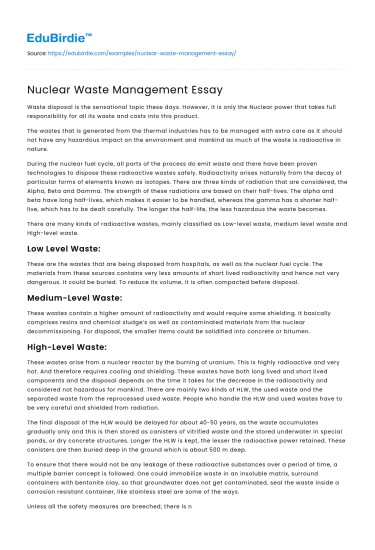Introduction
Nuclear energy plays a pivotal role in the global energy landscape, providing a reliable and efficient energy source with low carbon emissions. Despite its advantages, the management of nuclear waste remains a critical challenge that requires innovative solutions. Nuclear waste, composed of radioactive materials, poses significant risks to human health and the environment if not properly handled. Over the decades, various strategies have been developed to address these challenges, including geological disposal, reprocessing, and transmutation. This essay explores the complexities of nuclear waste management, examines existing solutions, and evaluates emerging technologies that promise to enhance safety and sustainability. By addressing counter-arguments and reviewing real-life cases, the discussion aims to present a comprehensive understanding of the current state and future prospects of nuclear waste management.
Challenges in Nuclear Waste Management
The management of nuclear waste is fraught with numerous challenges that stem from its hazardous nature and the long timescales over which it remains dangerous. High-level waste (HLW), such as spent nuclear fuel, is particularly problematic due to its high radioactivity and long half-life. According to the International Atomic Energy Agency (IAEA), safe management involves isolating and containing waste to prevent exposure to living organisms. One prominent method is geological disposal, where waste is stored in deep underground facilities designed to last for thousands of years. Finland's Onkalo repository is a prime example, pioneering the path for others with its robust barriers intended to prevent leakage.
Save your time!
We can take care of your essay
- Proper editing and formatting
- Free revision, title page, and bibliography
- Flexible prices and money-back guarantee
However, geological disposal is not without its critics. Opponents argue the uncertainty of geological stability over millennia poses significant risks. In addition, public opposition can hinder the development of such facilities. For instance, the Yucca Mountain project in the United States faced massive public and political resistance, leading to its eventual suspension. Such resistance underscores the importance of public trust and transparent communication in nuclear waste management. Addressing these challenges requires not only technical innovation but also societal engagement to build consensus and understanding.
Solutions and Technological Innovations
Amid the challenges, technological advancements offer promising solutions for nuclear waste management. One such innovation is the reprocessing and recycling of spent nuclear fuel to extract usable materials, thereby reducing waste volume and recovering valuable resources. France has successfully implemented reprocessing at its La Hague facility, enabling the country to reduce its overall waste footprint significantly. This approach not only mitigates the volume of waste but also extends the fuel supply for reactors, contributing to energy sustainability.
Another emerging technology is transmutation, which involves converting long-lived isotopes into shorter-lived ones through nuclear reactions. Transmutation has the potential to drastically reduce the longevity and toxicity of nuclear waste. Research into accelerator-driven systems (ADS) is advancing, with countries like Japan and Belgium investing in experimental setups to explore its feasibility. While promising, these technologies are not without their challenges, including high costs and technical complexities. Critics argue that reliance on unproven technologies could divert attention from immediate, more practical solutions like improving efficiency of current storage methods. Nevertheless, the potential benefits of reprocessing and transmutation make them essential components of a multifaceted approach to nuclear waste management.
Policy and Regulatory Frameworks
Effective nuclear waste management requires robust policy and regulatory frameworks to ensure safety and environmental protection. International guidelines, like those from the IAEA, provide a foundation for national policies, promoting best practices and encouraging collaboration. Nations must develop and enforce regulations that address all aspects of waste management, from production to final disposal. A key aspect is the establishment of clear responsibilities and liabilities, ensuring accountability and compliance.
The involvement of international bodies fosters cooperation and knowledge sharing, essential for addressing transboundary issues associated with nuclear waste. For instance, the European Union's Directive on the Management of Spent Fuel and Radioactive Waste sets a legal framework for member states to develop national programs, ensuring high safety standards. However, achieving global consensus on nuclear waste policies remains challenging due to varying national interests and capabilities. Critics argue that disparities in technological and financial resources can lead to inequitable management practices, potentially compromising global safety. Therefore, international collaboration and assistance are vital to harmonizing efforts and ensuring all countries can effectively manage nuclear waste.
Conclusion
Nuclear waste management is a complex and multifaceted challenge that requires a combination of technical, societal, and policy solutions. While existing methods like geological disposal offer viable options, emerging technologies such as reprocessing and transmutation hold the promise of more sustainable and effective waste management. Addressing the challenges requires not only technological innovation but also public engagement and robust regulatory frameworks to ensure safety and environmental protection. As the global demand for nuclear energy continues to grow, so too does the imperative to develop and implement comprehensive strategies for managing nuclear waste. By fostering international collaboration and embracing innovative approaches, the global community can navigate the challenges of nuclear waste management and contribute to a safer, more sustainable future.






 Stuck on your essay?
Stuck on your essay?

